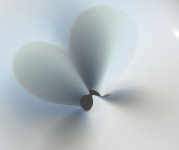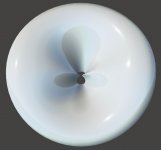1.4" throat version, ⌀480 x 240 mm (already a too low-resolution mesh):
Horizontal, vertical:



Diagonal at 30deg inclination, throat impedance:


Horizontal, vertical:
Diagonal at 30deg inclination, throat impedance:
Did you ever do a constant low directivity WG? A real "spreader" ... 🙂
Can we see one please?
//
Can we see one please?
//
wow i really have to learn to use ATH...
i'm assuming that the 'guides in post #10,463 finish in a round rolled over mouth horn...(?)
i'm assuming that the 'guides in post #10,463 finish in a round rolled over mouth horn...(?)
I 3D printed the ST260 KVAR horn and was able to do a few measurements before my measurement setup was damaged. Here are some results I got.
The compression driver I used along with this horn is Peerless DFM 2544R00-8 1 inch throat driver. This is a gated measurement with 4.06ms gate width and mic at 1m away from horn mouth. Measurement mic used in Dayton EMM-6.
I could get measurements only up to 60 degrees off axis in the horizontal plane before the horn and driver fell down and the horn was damaged.
I just used the files mabat had posted in a previous post in this thread (Thanks a lot for that) to print out the horn and assemble it like this:


Measurement setup

Raw measurements

Measurements normalized to ON-axis measurement

Thanks
Vineeth
The compression driver I used along with this horn is Peerless DFM 2544R00-8 1 inch throat driver. This is a gated measurement with 4.06ms gate width and mic at 1m away from horn mouth. Measurement mic used in Dayton EMM-6.
I could get measurements only up to 60 degrees off axis in the horizontal plane before the horn and driver fell down and the horn was damaged.
I just used the files mabat had posted in a previous post in this thread (Thanks a lot for that) to print out the horn and assemble it like this:
Measurement setup
Raw measurements
Measurements normalized to ON-axis measurement
Thanks
Vineeth
It's always nice to see someone actually doing something real. Good job.
I still have many my own pieces (one of them being a 1.4" KVAR version already mounted to the HF1440) waiting to be measured properly...
- In the meantime, a variation on the above theme (#10,461 etc.):
1" throat, ⌀480 x 190 mm:
Horizontal 0-90/5 deg:


Vertical:


Throat impedance:

There's no need for a spherical source in this case, I think.
It's hard to say how does it really work but the horizontal polars are among the best (if not the best) I've seen.
I still have many my own pieces (one of them being a 1.4" KVAR version already mounted to the HF1440) waiting to be measured properly...
- In the meantime, a variation on the above theme (#10,461 etc.):
1" throat, ⌀480 x 190 mm:
Horizontal 0-90/5 deg:
Vertical:
Throat impedance:
There's no need for a spherical source in this case, I think.
It's hard to say how does it really work but the horizontal polars are among the best (if not the best) I've seen.
Last edited:
Yes. It could also be morphed into a rectangle for a box mounting. Haven't tried that yet.i'm assuming that the 'guides in post #10,463 finish in a round rolled over mouth horn...(?)
No and no 🙂 (I don't think it's feasible)Did you ever do a constant low directivity WG? A real "spreader" ... 🙂
Can we see one please?
For a test, maybe such radial "blades" could be inserted even into an existing waveguide. 🤔
Last edited:
These remind me waveguides by Patrick Bateman - which were inspired by the image control waveguide by JBL. Do I see correctly, that the blades are vertically asymmetrical? Or is that only an optical illusion?
It has an exceptionally well-behaved directivity with no noticeable diffraction.
BTW, the above graphs are all for free standing devices (no infinite baffles). I didn't mention that.
BTW, the above graphs are all for free standing devices (no infinite baffles). I didn't mention that.
Last edited:
It may not be without issues though. This is for a 2" throat:

Horizontal (0-90/5):


Vertical:


It's hard to say if this can be further improved. 7 kHz still seems to be a kind of a limit for a 2" throat (and 14 kHz for a 1").
Horizontal (0-90/5):
Vertical:
It's hard to say if this can be further improved. 7 kHz still seems to be a kind of a limit for a 2" throat (and 14 kHz for a 1").
Non-normalized (constant acceleration) horizontal data:

It's not very nice any more above 7 kHz but it still has a manageable output to at least 11 kHz. Then it just narrows to nothing, as usual.
It's not very nice any more above 7 kHz but it still has a manageable output to at least 11 kHz. Then it just narrows to nothing, as usual.
stands to reason a 7khz wave is 1.937 inches so beyond that diffraction has a field day....
(2 inch throat right?)
(2 inch throat right?)
Sure. It's just seems to hold true no matter what we do.
Anyway, at 15° off-axis horizontally it's flat to at least 15 kHz 🙂 (not that the ears are not already pretty directional that high)
Anyway, at 15° off-axis horizontally it's flat to at least 15 kHz 🙂 (not that the ears are not already pretty directional that high)
Last edited:
- Home
- Loudspeakers
- Multi-Way
- Acoustic Horn Design – The Easy Way (Ath4)

